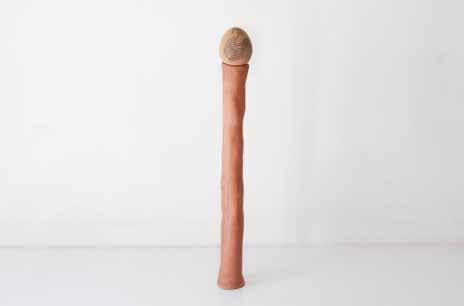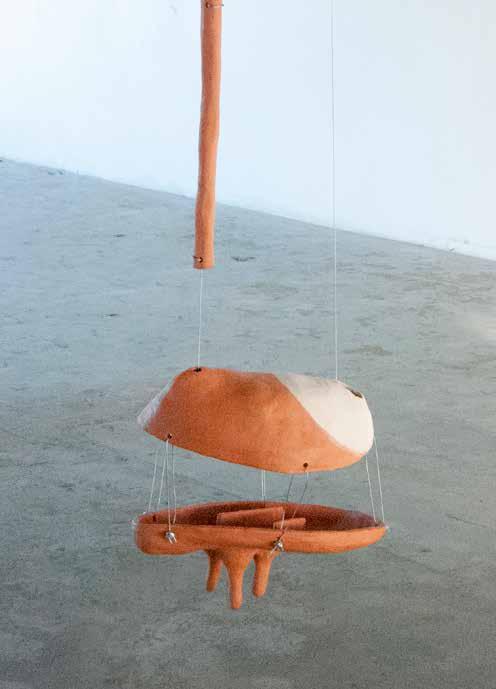
2 minute read
Mônica Coster
Teta trata das relações de alimentação e digestão travadas entre humanos e animais, dentro de um sistema de dominação e consumo. A instalação, feita de cerâmica, é composta por um duto vertical, fragmentado em quatro partes, que culmina em uma úbere bovina seccionada ao meio. Todas as peças são presas umas às outras e no teto com cabos de aço e anilhas, apresentando um corpo fragmentado, que não forma uma unidade coesa no espaço, composto apenas por esôfago e úbere. Um semianimal suspenso, como são as peças bovinas penduradas nos açougues. O trabalho parte de uma investigação sobre a figura conceitual do “gado”, grupo de animais criados em rebanho para fins alimentares, como agenciamento social, material e tecnológico que funciona como fonte e sustento para o sistema digestório humano.
Teta (Teat) deals with the relations of feeding and digestion between humans and animals, within a system of domination and consumption. The installation, made of ceramics, is composed of a vertical duct, fragmented in four parts, that culminates in a bovine udder sectioned in half. All the pieces are attached to each other and to the ceiling with steel cables and washers, presenting a fragmented body, which does not form a cohesive unit in space, composed only of esophagus and udder. A suspended semi-animal, like the bovine parts hung in butcher shops. The work starts from an investigation on the conceptual figure of “cattle”, a group of animals raised in herds for food, as a social, material, and technological agency that functions as a source and sustenance for the human digestive system.
Advertisement
Esôfago coloca em confronto a representação anatômica dos seres vivos e a materialidade do corpo animal presentificada no ovo da galinha. Sobre sua casca, o desenho do sistema digestório da ave aponta para a relação majoritariamente digestória que se estabelece entre humanos e animais e como estes, por sua vez, também se vinculam a outros seres dentro de uma cadeia alimentar. O trabalho se insere em uma investigação sobre a noção de “digestão expandida”, que considera a tessitura de relações de consumo e incorporação que envolvem o homem e a forma como influi sobre os seres que digere.
Esôfago (Esophagus) confronts the anatomical representation of living beings and the materiality of the animal body present in the chicken egg. On its shell, the drawing of the bird’s digestive system points to the mostly digestive relationship that is established between humans and animals and how these, in turn, are also linked to other beings within a food chain. The work is part of an investigation into the notion of “expanded digestion”, which considers the weaving of relations of consumption and incorporation that involve man and the way he influences the beings he digests.
Mônica Coster vive no Rio de Janeiro. Em seu trabalho, investiga os processos de digestão e decomposição, explorando o interior digestivo humano como um sistema que se expande para outros seres e arranjos biossociais ligados à comida. Cerâmica, alimentos e materiais vivos são elementos recorrentes em suas esculturas e instalações. Mônica possui graduação em Artes Visuais pela UFRJ e mestrado em Artes pela UFF e participou de diversas exposições coletivas, entre elas: I Prêmio Vozes Agudas, Galeria Jaqueline Martins, São Paulo; Siete Performances, o nueve, Galeria Isabel Hurley, Málaga e Salão Arte Londrina 7.
Mônica Coster lives in Rio de Janeiro. In her work, she investigates the processes of digestion and decomposition, exploring the human digestive interior as a system that expands to other beings and biosocial arrangements linked to food. Ceramics, food and organic materials are recurring elements in her sculptures and installations. Mônica has a bachelor’s degree in Visual Arts from UFRJ and a master’s degree in Arts from UFF. She has participated in several group exhibitions, including: I Prêmio Vozes Agudas (First Acute Voices Award) at Galeria Jaqueline Martins, São Paulo; Siete Performances, o nueve (Seven Performances, or Nine), Isabel Hurley Gallery, Málaga; and Salão Arte Londrina 7.











